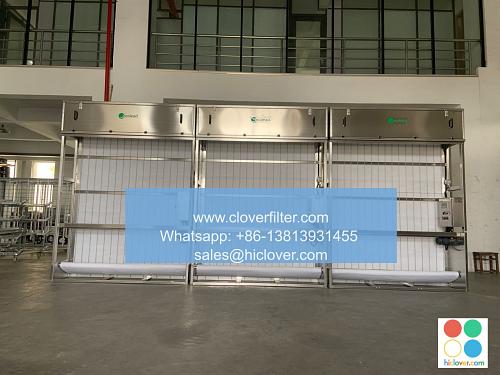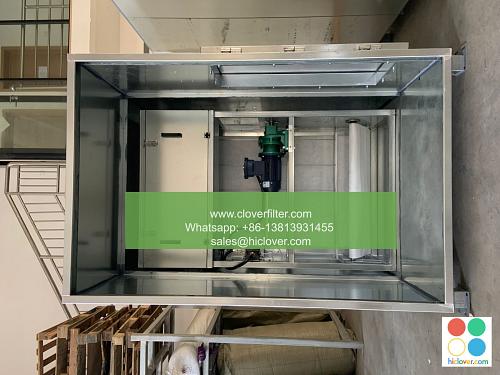The Impact of Automatic Roll Air Filters on Food Packaging Facility Maintenance

Food packaging facilities require a clean and controlled environment to ensure the quality and safety of their products. One crucial aspect of maintaining this environment is the air filtration system. Traditional air filters can be cumbersome and require frequent replacement, which can lead to increased maintenance costs and downtime. Automatic roll air filters have emerged as a promising solution to address these challenges. In this article, we will explore the impact of automatic roll air filters on food packaging facility maintenance.
Traditional air filters are typically replaced every 1-3 months, depending on the facility’s air quality and filtration needs. This replacement process can be time-consuming and labor-intensive, requiring maintenance personnel to shut down the air handling system, remove the old filter, and install a new one. In contrast, automatic roll air filters are designed to automatically advance a new section of filter media as the old one becomes dirty, eliminating the need for frequent replacements. This can significantly reduce maintenance downtime and labor costs.
Another advantage of automatic roll air filters is their ability to maintain a consistent level of air quality. Traditional filters can become less effective over time, allowing particles and contaminants to enter the facility and compromise product quality. Automatic roll air filters, on the other hand, ensure a consistent level of air quality by continuously replacing the filter media with a new, clean section. This is particularly important in food packaging facilities, where even small amounts of contamination can have serious consequences.
In addition to reducing maintenance costs and improving air quality, automatic roll air filters can also help to minimize waste and reduce the facility’s environmental footprint. Traditional filters are typically replaced in their entirety, resulting in a significant amount of waste. Automatic roll air filters, by contrast, only advance a new section of filter media as needed, reducing the amount of waste generated. This can be an important consideration for facilities seeking to reduce their environmental impact and improve their sustainability credentials.
The installation and operation of automatic roll air filters are also relatively straightforward. The filters are typically installed in the air handling system and can be integrated with existing control systems. The automatic roll air filter is designed to operate continuously, advancing a new section of filter media as needed. This eliminates the need for manual intervention and minimizes the risk of human error. Maintenance personnel can focus on other critical tasks, such as equipment maintenance and repairs.
Furthermore, automatic roll air filters can help to improve the overall efficiency of the air handling system. By maintaining a consistent level of air quality, the system can operate more efficiently, reducing energy consumption and costs. This can be particularly important in food packaging facilities, where energy costs can be a significant expense. By improving the efficiency of the air handling system, facilities can reduce their energy costs and improve their bottom line.
In conclusion, automatic roll air filters can have a significant impact on food packaging facility maintenance. By reducing maintenance costs, improving air quality, minimizing waste, and improving efficiency, these filters can help facilities to operate more effectively and efficiently. As the food packaging industry continues to evolve, it is likely that automatic roll air filters will become an increasingly important component of facility maintenance strategies.
Conclusion: The use of automatic roll air filters in food packaging facilities can have a significant impact on maintenance costs, air quality, and overall efficiency. By reducing the need for frequent filter replacements, minimizing waste, and improving air quality, these filters can help facilities to operate more effectively and efficiently. As the industry continues to evolve, it is likely that automatic roll air filters will become an increasingly important component of facility maintenance strategies.
Frequently Asked Questions (FAQs)
Q: How often do automatic roll air filters need to be replaced?
A: Automatic roll air filters are designed to automatically advance a new section of filter media as the old one becomes dirty, eliminating the need for frequent replacements. The filter media can last for several months, depending on the facility’s air quality and filtration needs.
Q: Can automatic roll air filters be integrated with existing control systems?
A: Yes, automatic roll air filters can be integrated with existing control systems, allowing for seamless operation and minimizing the need for manual intervention.
Q: Do automatic roll air filters require special maintenance or upkeep?
A: No, automatic roll air filters are designed to operate continuously with minimal maintenance or upkeep. The filters are typically installed in the air handling system and can be monitored remotely to ensure optimal performance.
Q: Can automatic roll air filters be used in conjunction with other air filtration systems?
A: Yes, automatic roll air filters can be used in conjunction with other air filtration systems, such as HEPA filters or activated carbon filters, to provide a comprehensive air filtration solution.


